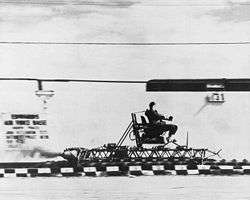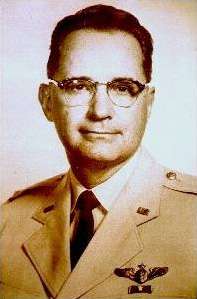John Stapp
| John Stapp | |
|---|---|
|
Stapp in his Air Force uniform | |
| Born |
John Paul Stapp July 11, 1910 Bahia, Brazil |
| Died |
November 13, 1999 (aged 89) Alamogordo, New Mexico |
| Resting place |
Fort Bliss National Cemetery El Paso, Texas |
| Residence | Alamogordo, New Mexico |
| Citizenship |
|
| Nationality | American |
| Fields |
Physics (Acceleration) Physician and Medicinal science |
| Alma mater |
Baylor University (B.A. 1931, M.A. 1932) University of Texas (Ph.D., 1940) University of Minnesota (M.D., 1944) |
| Known for | Study of deceleration on humans, Stapp's Law |
| Notable awards |
Elliott Cresson Medal (1973) Gorgas Medal (1957) |
Colonel John Paul Stapp, (July 11, 1910 – November 13, 1999) M.D., Ph.D., was an American career U.S. Air Force officer, flight surgeon, physician, biophysicist, and pioneer in studying the effects of acceleration and deceleration forces on humans.[1] He was a colleague and contemporary of Chuck Yeager, and became known as "the fastest man on earth".[2]
Early years
Born in Salvador de Bahia, Brazil, Stapp was the eldest of four sons of Reverend and Mrs. Charles F. Stapp, Baptist missionaries. He studied in Texas at Brownwood High School in Brownwood and San Marcos Baptist Academy in San Marcos.
In 1931, Stapp received a bachelor's degree from Baylor University in Waco, an MA from Baylor in 1932, a PhD in Biophysics from the University of Texas at Austin in 1940, and an MD from the University of Minnesota, Twin Cities, in 1944. He interned for one year at St. Mary's Hospital in Duluth, Minnesota. Stapp was later awarded an honorary Doctor of Science from Baylor University.
Military career

Stapp entered the Army Air Corps on 5 October 1944 as a physician. On 10 August 1946, he was assigned to the Aero Medical Laboratory at Wright Field as a project officer and medical consultant in the Biophysics Branch.[3] His first assignment included a series of flights testing various oxygen systems in unpressurized aircraft at 40,000 ft (12.2 km). One of the major problems with high-altitude flight was the danger of "the bends" or decompression sickness. Stapp's work resolved that problem as well as many others, which allowed the next generation of high-altitude aircraft and the HALO insertion techniques. He was assigned to the deceleration project in March 1947.[4]
In 1967, the Air Force loaned Stapp to the National Highway Traffic Safety Administration to conduct auto-safety research. He retired from the U.S. Air Force in 1970 with the rank of colonel.
Works on effects of deceleration
As far back as 1945, service personnel realized the need for a comprehensive and controlled series of studies. This led to fundamental concepts that could apply to better safeguard aircraft occupants during a crash. The initial phase of the program, as set up by the Aero Medical Laboratory of the Wright Air Development Center, was to develop equipment and instrumentation. This was so aircraft crashes might be simulated, and to study the strength factors of seats and harnesses. Human tolerance to the deceleration encountered in simulated aircraft crashes could also be simulated.[5]
The first run on the rocket sled took place 69 years ago on 30 April 1947 with ballast. The sled ran off the tracks. The first human run took place the following December. Instrumentation on all the early runs was in the developmental stage, and it was not until August 1948 that it was adequate to begin recording. By August 1948, sixteen human runs had completed, all in the backward-facing position. Forward-facing runs started in August 1949. Most of the earlier tests ran to compare the standard Air Force harnesses with a series of modified harnesses. This was to determine which type gave the best protection to the pilot.
By June 8, 1951, a total of 74 human runs had been made on the decelerator, 19 with the subjects in the backward position, and 55 in the forward position. Stapp, one of the most frequent volunteers on the runs, sustained a fracture of his right wrist during the runs on two separate occasions.
Stapp's research on the decelerator had profound implications for both civilian and military aviation. For instance, the backward-facing seat concept, which was known before, was given great impetus by the officer's crash research program. It proved beyond a doubt that this position was the safest for aircraft passengers and required little harness support.[5] Also, that a human can withstand much greater deceleration than in the forward position. As a result, many Military Air Transport Service (MATS) aircraft in USAF were equipped or retrofitted with this type of seat. Commercial airlines were made aware of these findings, but still use forward-facing seats. The British Royal Air Force also installed it on many of their military transport aircraft.
As a result of Stapp's findings, the acceleration requirement for fighter seats was increased considerably up to 32 g (310 m/s²). His work showed that a pilot could walk away from crashes when properly protected by harnesses if the seat does not break loose.
The "side saddle" or sideways-facing harness was also developed by Stapp. The new triangular-shaped harness gave vastly increased protection to fully equipped paratroopers. It was made of nylon mesh webbing, fit snugly over the shoulder facing the forward part of the aircraft. It protected the wearer from the force of crash impacts, takeoffs and landing bumps. It withstood a crash force of approximately 8,000 lbf (35,600 N) of force and was developed to replace the old-fashioned lap belts, which gave inadequate protection to their wearers.
By riding the decelerator sled himself, in his 29th and last ride at Holloman Air Force Base in New Mexico, Stapp demonstrated that a human can withstand at least 46.2 g (in the forward position, with adequate harnessing). This is the highest known acceleration voluntarily encountered by a human, set on December 10, 1954.[6] Stapp reached a speed of 632 mph (1,017 km/h),[7] which broke the land speed record and made him the fastest man on earth. Stapp believed that the tolerance of humans to acceleration had not yet been reached in tests. He believed it is much greater than thought possible.
Also developed by Stapp as an added safety measure was an improved version of the currently used shoulder strap and lap belt. The new high-strength harness withstood 45.4 g (445 m/s²), compared to the 17 g (167 m/s²), which was the limit that could be tolerated with the old combination. Basically, the new pilot harness added an inverted "V" strap crossing the pilot's thighs added to the standard lap belt and shoulder straps. The leg and shoulder straps and the lap belt all fastened together at one point, and pressure was distributed evenly over the stronger body surfaces, rather than on the solar plexus, as was the case with the old harness.
Wind-blast experiments
Stapp also participated in wind-blast experiments, in which he flew in jet aircraft at high speeds to determine whether or not it was safe for a pilot to remain with his aircraft if the canopy should accidentally blow off. Stapp stayed with his aircraft at a speed of 570 mph (920 km/h) with the canopy removed, and suffered no injurious effects from the wind blasts. Among these experiments was one of the first high-altitude skydives, executed by Stapp himself. He also supervised research programs in the field of human factors in escape from aircraft.
Stapp's law
Stapp was an inveterate collector of aphorisms and adages, kept a logbook of such, and the practice spread to his entire working group. He published a collection of these in 1992.[8] Stapp is credited with being the popularizer, as well as of the author of the final form of the principle known as Murphy's law, "Anything that can go wrong, will go wrong." [9]
Stapp is credited with creating Stapp's Law (or Stapp's Ironic Paradox) during his work on the project. It states "The universal aptitude for ineptitude makes any human accomplishment an incredible miracle."[10]
Awards
In 1957, he was presented with the Gorgas Medal from the Association of Military Surgeons of the United States (AMSUS). In 1973 Stapp was awarded the Franklin Institute's Elliott Cresson Medal. In 1979 Stapp was inducted into the International Space Hall of Fame.[11] The New Mexico Museum of Space History, which houses the International Space Hall of Fame, includes a John P. Stapp Air & Space Park which holds Sonic Wind No. 1, a rocket sled ridden by Stapp.
In 1985, Stapp was inducted into the National Aviation Hall of Fame for his work in aviation safety.
In 1991, Stapp was awarded the National Medal of Technology, "for his research on the effects of mechanical force on living tissues leading to safety developments in crash protection technology".
Later life
In the years before his death, Stapp was president of the New Mexico Research Institute, headquartered in Alamogordo, New Mexico, as well as chairman of the annual Stapp Car Crash Conference. This event meets to study car crashes and determine ways to make cars safer. In addition, Stapp was honorary chairman of the Stapp Foundation, which is underwritten by General Motors and provides scholarships for automotive engineering students.
Stapp died peacefully at his home in Alamogordo at the age of 89.
See also
Video
- Manned rocket sled run – Discovery Channel on YouTube
- Col John Stapp Takes a Lot of G's – History Channel on YouTube
- Americian Experience - Space Men on PBS
References
- ↑ Giannettino, Judy (December 9, 1984). "His swift rides saved thousands of lives". The Day. New London, Connecticut. Associated Press. p. A20.
- ↑ Spark, Nick T. "The Fastest Man Alive". Improb.com. Retrieved 2010-03-02.
- ↑ "Building 29: Aero Medical Laboratory". Historic Buildings & Sites at Wright-Patterson AFB. United States Air Force. 2002-08-12. Retrieved 2008-11-15.
- ↑ Spark, Nick T. "The Story of John Paul Stapp". The Ejection Site.
- 1 2 Stapp JP (August 1948). "Problems of human engineering in regard to sudden declarative forces on man". Mil Surg. 103 (2): 99–102. PMID 18876408.
- ↑ Thompson, Ronnie (July 23, 1964). "'Fastest Man' title stands". Eugene Register-Guard. Oregon. Associated Press. p. 8B.
- ↑ "Base re-enacts rocket sled test". Spartanburg Herald-Journal. South Carolina. wire reports. December 12, 2004. p. A5.
- ↑ Stapp, John Paul (1992). For Your Moments of Inertia: From Levity to Gravity: A Treatise Celebrating your Right to Laugh. no publisher. OCLC 33150804.
- ↑ http://www.improb.com/airchives/paperair/volume9/v9i5/murphy/murphy1.html
- ↑ "Technology bites back". The Sydney Morning Herald. 9 April 2005.
- ↑ "International Space Hall of Fame Inductee Profile: John P. Stapp". New Mexico Museum of Space History. Retrieved 2008-06-13.
- Notes
- "Biography of Dr. John P. Stapp". Air Force Flight Test Center Public Affairs Office, Edwards Air Force Base. Archived from the original on 2006-12-07. Retrieved 2009-08-09.
- "USAF People". The Air Force Museum, Wright Patterson Air Force Base. Retrieved 17 April 2007.
- "John Stapp — Scientist". National Aviation Hall of Fame. Retrieved 17 April 2007.
External links
| Wikiquote has quotations related to: John Stapp |
| Wikimedia Commons has media related to John Stapp. |
- Book mainly about Stapp's work and his teams
- Stapp Car Crash Conference
- Air Force Magazine article on Stapp's research
- Encyclopedia Astronautica
